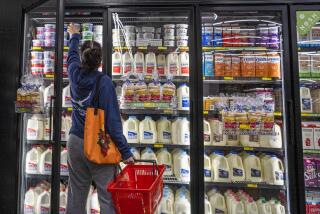Economists Discount Threat of Higher Inflation : Producer Prices Up 4th Straight Month
- Share via
WASHINGTON — The cost of clothing and home electronics equipment rose last month, helping to drive up wholesale prices by 0.2%, the Labor Department reported Friday.
Although wholesale prices have risen for four consecutive months, there does not seem to be a major threat of an inflationary revival. In fact, the overall cost of food at the wholesale level declined slightly during November.
Most economists share the view of the Reagan Administration that food and fuel prices will remain relatively stable because of ample worldwide supplies. The modest increase in prices will come from the rest of the economy.
Annual Rate of 3.8%
Prices have been rising at an annual rate of 3.8% during the last three months, a figure “generally consistent with the Administration’s forecast of a moderate 3.6% rate of inflation for the coming year,” White House spokesman Larry Speakes said.
The government measures wholesale price increases through its producer price index, which rose a moderate 0.2% during November, compared to increases of 0.3% in October and 0.4% during September and August.
“I’m generally satisfied with this level of inflation,” said Kathleen Cooper, senior vice president and chief economist at Security Pacific National Bank in Los Angeles. “I look back at 1980 and double-digit inflation, and I feel relieved.”
The higher wholesale prices usually translate into increases for consumers at the retail level, after a lag from a few weeks to several months, depending on the product.
Wholesale prices had plunged early in the year because of the precipitous drop in the cost of oil. Despite four straight months of inflation, wholesale prices are still below the levels of a year ago, reflecting an astounding 37% plunge in energy prices. The savings in fuel costs far outweighed the 4.1% advance in food prices and the 3% increase in the cost of other consumer goods.
Energy Prices Unchanged
Energy prices were unchanged in November, and overall food costs fell 0.1%. Fresh vegetables and eggs cost more last month, but fruits, poultry and fish were cheaper.
With energy and food costs less volatile, the November increase in the wholesale price index therefore reflects modest inflation throughout the rest of the economy.
For example, the cost of women’s clothing rose 0.2% during November, while men’s apparel cost 0.5% more. Home electronic equipment and furniture prices each rose 0.3%, and toys and games cost 0.2% more.
The formal producer price index during November was 290.7, meaning a combination of goods priced at $100 in 1967 cost $290.70 last month.
Prices are likely to keep rising only slowly because there is plenty of excess manufacturing capacity, said Frantz Price, director of cost planning services at Chase Econometrics, a Bala-Cynwyd, Pa., forecasting firm. “We have some ways to go before there is any pressure on the supply side,” he said.
Prices tend to rise when factories are operating close to capacity, and companies face possible shortages of personnel and materials. But all these factors of production are in ample supply.
Business Remains Sluggish
Experts believe that the economy is in no danger of overheating and, in fact, business is somewhat sluggish. Inventories rose a substantial 0.6% in October as sales by U.S. business declined 1.6%, the Commerce Department reported.
The increase in unsold merchandise was the biggest since an inventory buildup of 0.7% during September, 1984. National sales totals fell in October because car sales were slow after auto makers stopped their program of subsidizing low-interest loans.
Although inflation is not a major threat now, prices are expected to begin rising more rapidly during the second half of 1987.
Impact of Falling Dollar
The dollar has fallen sharply in relation to the currencies of many European nations and Japan, making their products more costly to American buyers. The rising import prices also allow American producers to boost their own prices for the domestic market.
“There will be some acceleration in prices” because of the impact of the change in the dollar’s value, said Cooper of Security Pacific.
However, the inflationary pressures from imports will be mixed, said Price of Chase Econometrics. Goods from Europe and Japan may cost more. But producers from Canada, South Korea, Brazil, Hong Kong and Taiwan will be heavily competitive because their comparative prices in dollar terms have not risen, he said.
More to Read
Get the L.A. Times Politics newsletter
Deeply reported insights into legislation, politics and policy from Sacramento, Washington and beyond. In your inbox twice per week.
You may occasionally receive promotional content from the Los Angeles Times.









